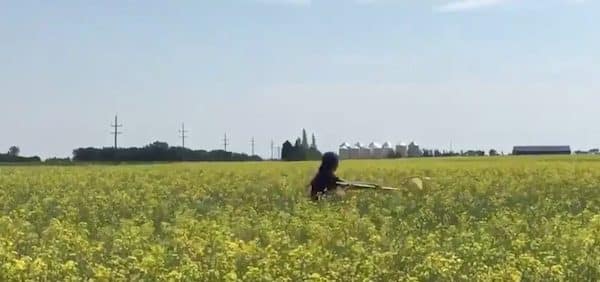Thresholds for lygus bugs and cabbage seedpod weevil are based on a specific sweep net technique. If you’re not doing a complete 180° pattern, walking while you sweep, and keeping the net near the top of the canopy, your counts could be significantly different from someone using the recommended techniques.
Here are the recommended sweep net techniques:
–The standard sweep net has a 35” long handle and 15” (38 cm) diameter net.
–Sample preferably when the foliage is dry. If the foliage is wet, small insects may stick to the inside of the sweep net bag, making it difficult to identify them and give you an inaccurate count.
–Keep the net path parallel to the ground.
–Tilt the net opening so the lower edge of the rim is slightly ahead of the upper rim.
–Swing the net from side to side in a full 180-degree arc. Sweep one stroke per step as you casually walk through the field or down the row.
–In short vegetation, swing the net as deeply as possible. In taller vegetation, sweep only deep enough to keep the upper edge of the sweep net opening even with the top of the plants. In general, don’t let the net go more than 25 cm (10”) below the top of the plants.
–Each passage of the net is considered one sweep. Thresholds are based on 10 sweeps.
Other considerations:
Even if a region doesn’t typically have lygus or cabbage seedpod weevil, a sweep net can be useful to identify the presence of beneficial insects, of diamondback moth larvae and other insect pests. Finding these insects in the sweep net would lead you to scout again using proper techniques for each insect.
Large Ziploc bags, especially the breathable ones, are a handy companion for the sweep net. Flying insects can pop out of the net quickly, making it harder to do an accurate count. Carefully dump all contents into a Ziploc bag, then count insects through the perforated bag.
Sweep net results can be highly variable throughout a field. For cabbage seedpod weevil (CSPW), sweep in two locations about 50 m apart then in another two locations in a completely different area of the field, again 50 m apart. As they first move into a field, CSPW can accumulate in high numbers along field margins. Therefore, scouting at field edges may not accurately predict insect numbers across the whole field.
Time of day: Temperature and wind speed can make a difference in lygus counts. You may want to scout two days in a row, unless average numbers are well above threshold.
Field Heroes sweep net videos and tips
Videos on how to sweet net:
John Gavloski
Scott Meers
Hector Carcamo
You know it’s a good field when it’s tough to sweep through! #ManDown #scout17 #WhereThemBugsAt #CdnAg pic.twitter.com/pL81kVecZm
— Justine Cornelsen (@CornelsenCCC) July 10, 2017

